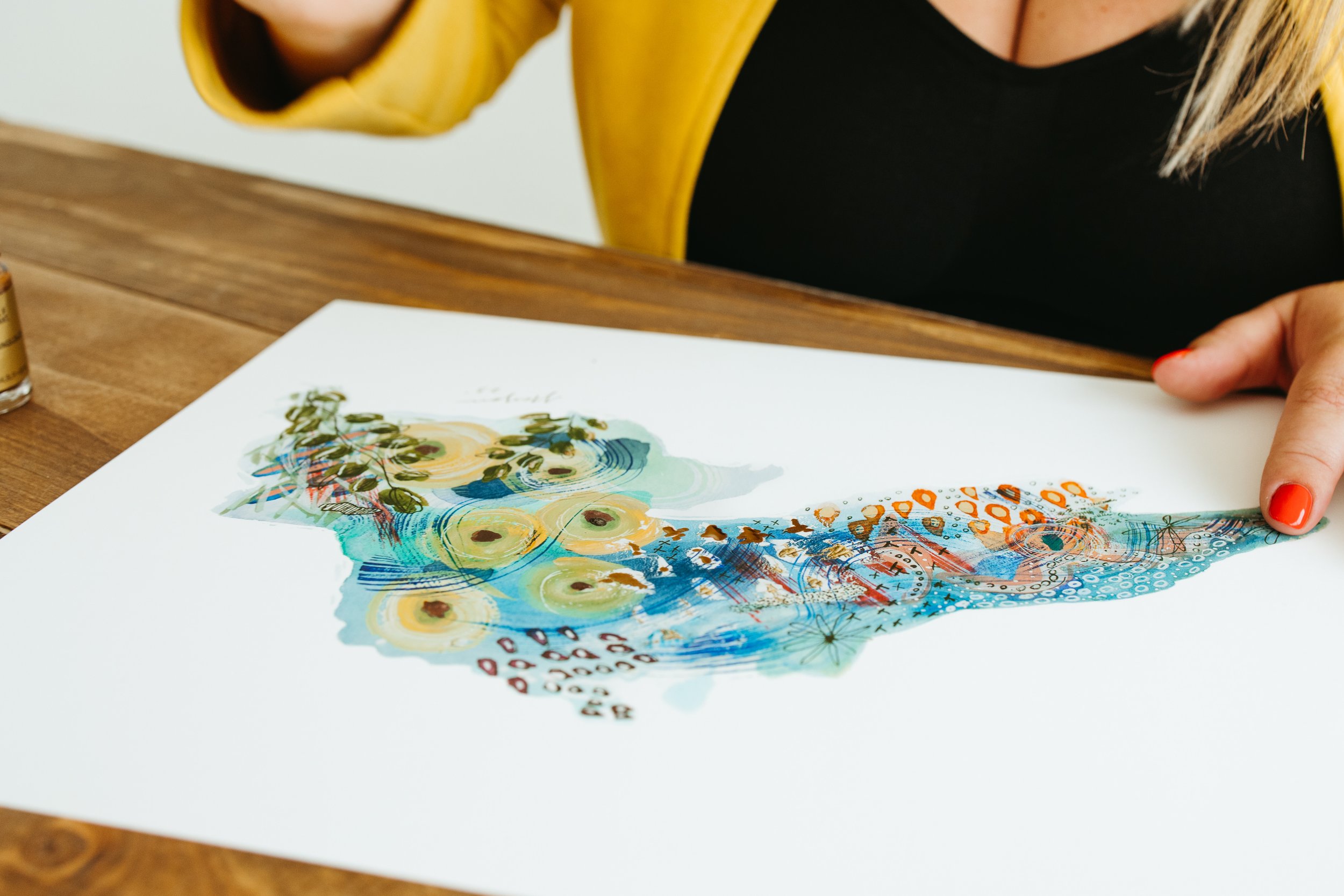FAQ
-
YES! However I only do a limited availability for the year, and time can vary based on season. Read Here to learn how my commission process works.
-
For my original artworks, I exclusively use Arches Cold Press paper. Here are the specifications for this paper:
Arches Cold Press paper refers to a specific type of high-quality watercolor paper produced by the renowned paper mill Arches. Here's a brief overview of its characteristics and production process:
Weight: The weight of the paper, indicated as 140lb/300gsm, denotes its thickness and sturdiness. Heavier weights are more durable and can withstand multiple washes and layers of paint.
Texture: Cold press refers to the surface texture of the paper. Cold press paper has a slightly textured surface, which provides an interesting and versatile surface for watercolor painting. It allows for both controlled detail work and expressive washes.
Material: Arches Cold Press paper is made from pure cotton fibers, ensuring exceptional durability, longevity, and resistance to warping or buckling when wet.
Quality: The paper is acid-free, which means it is pH neutral and will not yellow or degrade over time. This ensures the longevity of your artwork.
Suitability: Arches Cold Press paper is specifically designed for use with watercolors. Its absorbent surface allows for excellent color control and blending, making it a preferred choice among professional artists.
Arches Cold Press paper is meticulously crafted using traditional techniques that have been perfected over centuries, resulting in a paper that meets the highest standards of quality and performance for watercolor painting.
-
For my prints, I collaborate with CPL Imaging, a trusted fine art printer based in Duluth, Minnesota. Here are the specifications for the paper used for my prints:
Type: Giclée Hot Press paper
What does "Giclée" mean and why is it trusted for fine art prints?
The term "Giclée" (pronounced zhee-CLAY) refers to a high-quality printing technique often used for fine art reproduction. Here's why it's trusted for fine art prints:
Definition: Giclée printing involves using specialized inkjet printers and archival quality inks to produce high-resolution prints with exceptional color accuracy and detail reproduction.
Quality: Giclée prints are renowned for their museum-quality standards. The combination of archival inks and premium paper ensures that the prints have longevity and resistance to fading, allowing them to maintain their vibrancy and clarity for generations.
Versatility: Giclée printing allows for a wide range of substrates to be used, including various types of paper and canvas. This versatility enables artists to choose the medium that best complements their artwork, whether it's a smooth hot press paper for intricate details or a textured canvas for a more painterly effect.
Collaborating with CPL Imaging ensures that my prints are produced using the highest standards of quality and craftsmanship, resulting in stunning reproductions that capture the essence of the original artwork.
-
I have dedicated a lot of time to researching and finding supplies that I think you will love! My Amazon store is linked here. You will find a list of supplies for beginners, as well as more advanced painters. As I create I am always finding and trying new supplies and testing them out, my recommendations will evolve, so make sure you check back here periodically.
-
YES! Local to Duluth, MN my artwork is sold at the lovely brick and mortar store North & Shore in the Lincoln Park craft district

More to Know
-
I've always been drawn to the delicate dance between watercolor, ink, and gouache, which form the cornerstone of my artistic expression. While I've received some formal art education, much of my journey has been one of self-discovery and exploration.
-
Nature is my muse, and the rugged beauty of Minnesota's wilderness, coupled with the serene majesty of Lake Superior, fuels my imagination and infuses my work with a sense of wonder and reverence.
-
My creative process is as varied as the landscapes I paint. Sometimes, I'm captivated by a specific scene or image, and it becomes my singular focus. Other times, my paintings evolve over months, with layers of color and emotion added whenever inspiration strikes.
-
Process art refers to a form of artistic creation where the focus lies more on the process of making art rather than on the end product itself. In process art, the emphasis is on the act of creation, exploration, experimentation, and the materials used rather than on producing a finished, tangible artwork.
The process is often intuitive and spontaneous, allowing for chance, improvisation, and discovery along the way. Artists engaged in process art may use various techniques such as dripping, pouring, splattering, or layering of materials. The final result might not be predetermined, and the artwork may evolve and change as the artist engages with the materials and the creative process.
Process art emerged in the mid-20th century as a reaction to traditional notions of art-making and the emphasis on the final product. It celebrates the act of creating and the experience of art-making, inviting viewers to appreciate the journey and the artist's engagement with their materials and ideas.
-
Watercolor fine art refers to artwork created using watercolor as the primary medium, typically on high-quality paper. This form of art involves the application of pigment mixed with water onto a surface, allowing for translucent layers of color to be built up gradually. Watercolor fine art often emphasizes the fluidity, transparency, and luminosity of the medium, resulting in delicate and nuanced compositions.
In watercolor fine art, artists employ various techniques such as wet-on-wet, wet-on-dry, and dry brushing to achieve different effects and textures. The nature of watercolor allows for a range of styles, from loose and expressive to detailed and precise. Artists may use brushes of different sizes and shapes to control the application of paint and create a variety of marks and lines.
Watercolor fine art is valued for its ability to capture the subtleties of light and color, as well as its expressive and spontaneous qualities. It is often used to depict a wide range of subjects, including landscapes, portraits, still lifes, and abstract compositions. Watercolor paintings are prized for their ethereal beauty, evocative mood, and emotional resonance, making them a popular choice among artists and collectors alike.
-
I believe art is a bridge that connects hearts and minds. Through my work, I hope to evoke the same sense of awe and tranquility that I feel when immersed in nature's embrace. Each brushstroke is a whisper, inviting you to pause, reflect, and find solace in the beauty of the world around us.
-
As I continue to grow and evolve as an artist, I'm excited to embark on new creative journeys and explore uncharted territories of expression. From intimate vignettes to sweeping landscapes, my art is a testament to the boundless possibilities of imagination.


